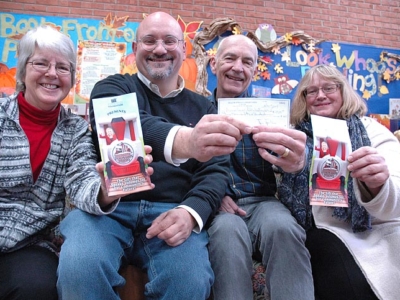Zoning update on final round
- Published: September 19, 2013
Say you want to build a new home, but you want it to be a tiny house, in order to live in an environmentally sustainable way, or perhaps just to downsize. While the previous Yellow Springs zoning code would have restricted your right to build a house below minimum size standards, the newly revised code says you can build a home as small as you want.
Or perhaps you want to start a new business in your home, as a way to launch a creative yet risky venture without the added cost of renting outside space. While the old zoning code would have allowed you to have a home business only if you live in one specific housing district, the new code allows home business in all three housing districts as long as you first bring your proposal to Planning Commission and the planners approve.
These are two examples of how the new Yellow Springs zoning code could allow more flexibility in how Yellow Springers live and work. Council passed the first reading of the updated code at its Sept. 3 meeting, and will vote on the second and final reading of the code at its next meeting on Sept. 16 at 7 p.m. at Council chambers.
The purpose of the code update, which was a two-year effort of community volunteers, Planning Commission and Village Council, was to “open things up, make more things possible,” Council President Judith Hempfling wrote in an email this week. “Originally, we were motivated by the fact that the old code was outdated and preventing innovative development from occurring, development which fit community values.”
The code update was also a priority set by the Village Comprehensive Plan, and a goal that emerged from the community-wide visioning effort of 2010, both of which urged the Village to expand its tax base by promoting infill rather than extending Village borders.
The code revision process began with the formation of the Technical Review Committee, or TRC, a group of villagers with expertise in housing issues who met with Planning Consultant Paul LeBlanc to rewrite the old code. The code update next went before Planning Commission, which reviewed suggested changes for several months, then to the final stage of Village Council approval.
The finished update is not as flexible as Hempfling would have liked, as she proposed more flexibility in multifamily dwellings and accessory dwellings that failed to pass Council. But overall it’s a code that is intended to help the village grow itself in creative ways, she said.
“I hope it will be a set of rules that support the creative activities of people of all economic levels and not just those of the more financially well off. And I hope the Village Council and Planning Commission will amend it when it is not supporting our original goals,” she said.
Part of Council’s intent in updating the code was to address the need of allowing homes that are more affordable and environmentally sustainable, according to Council member Rick Walkey, who in an interview this week said, “I hope it’s fruitful. We worked hard to include language that allows as much as possible.”
However, implementation of the code will be key, Walkey said, and he’s concerned that now that the Village has a new set of rules, the implementation stay in the same “friendly, laissez-faire” style that it has been in the past rather than being “overly officious.”
According to Council member Lori Askeland, who as a member of Planning Commission addressed the code update in all its stages, “It was extremely important to bring the code into compliance with the dreams expressed in our visioning process and through our updated Comprehensive Plan: maintaining a human scale, walkability, bikeability, affordability and also encouraging businesses to grow.”
The code overall provides balance, Askeland said in an email this week.
“My hope is that we have a flexible plan that encourages creativity and the entrepreneurial spirit, while respecting the need for neighbors to live in peace and have some sense that they will have a say if there are changes that might be disruptive to their lives, and/or would be likely to significantly hurt property values,” she wrote.
At Council’s Sept. 3 meeting, villagers’ concerns on the code update mainly came from neighbors of the Antioch College farm. The college had requested that it be permitted to add large animals to its farm’s educational activity, but neighbors protested that cows and pigs would introduce smells and noise that could be harmful to the neighborhood. Ultimately, the farm activity was approved as a conditional use, which means that college officials need to come before Planning Commission before making changes to the current farm operation, which includes about 50 chickens and ducks along with cultivation of vegatables.
At the Sept. 3 meeting, several neighbors sought reassurance that college leaders couldn’t make major changes to the farm without their knowledge and consent.
Because Council approved the farming operation as a conditional use, “the college has to show it won’t negatively impact the neighbors’ property” before making changes, according to Council member Lori Askeland.
In other Council business:
• Council approved a renewal of the AMP Energy Smart program, which provides cost savings for villagers who take part and reduce energy use, according to Village Manager Laura Curliss. According to Council member Karen Wintrow, Energy Smart is “an incredible program” that is working closely with Antioch College in its efforts to be environmentally sustainable.
• Council heard a presentation from Village Treasurer Rachel McKinley, who recommended moving Village investment funds to a Star Plus account at US Bank, which would pay more interest than the bank’s Star Ohio program. Interest continues to be low, and is likely to remain so in the near future, McKinley said, but the switch in programs would provide some additional income.
“It’s a no-brainer,” she said.
• Council acknowledged receiving a petition from residents of the Fair Acres neighborhood, who are concerned about the condition of their streets. The solution to the street problems is extensive and costly, according to Curliss. Hempfling stated that Council will soon discuss the Fair Acres situation.
• Council acknowledged receiving a letter from Green Environmental Coalition head Vickie Hennessey regarding concern over a recent violation notice that Morris Bean received from the Ohio EPA around the company dumping discharge into a sinkhole. The issue is a concern due to the company’s proximity to the Village source water protection area, Hennessy said.
• Council’s next regular meeting is Monday, Sept. 16 at 7 p.m. in Council chambers.














No comments yet for this article.